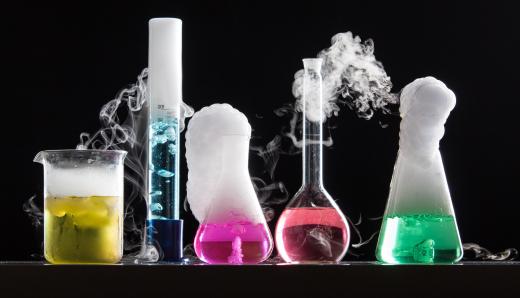What is Bond Enthalpy?
 Karyn Maier
Karyn Maier
Bond enthalpy is a term used in the study of thermodynamics that refers to the amount of energy required to break the chemical bond forged between any two atoms within a molecule. Since bond strength varies among chemical reactions, the bond enthalpy values contained in the Table of Bond Enthalpies are given as averages. Usually, these values are expressed as kJ/mol, although they sometimes appear as kJ mol-1. Since this value can be used to determine the heat exchange expected to occur in chemical reactions, it is sometimes used interchangeably with the terms bond dissociation enthalpy and bond dissociation energy.
Chemical bond breaking occurs in different ways. Fission or cleavage of a neutral molecule that results in an anion (negatively charged ion) and a cation (positively charged ion) has taken place via heterolysis. In contrast, if breaking the bond of a molecule results in two unpaired electrons, or free radicals, then the process has been initiated through homolytic fission.

In molecular chemistry, bond enthalpy also refers to the probability for a thermodynamic reaction within a system. One of the variables for this potential to consider is, of course, bond strength. Generally speaking, the strongest bonds are found in the shortest formations since there are fewer molecules involved. In addition, in order for the reaction to be endothermic, the system must receive energy. Otherwise, with a loss of energy, the reaction would be defined as being exothermic and would produce a new bond of lower enthalpy.

Given the above, it can also be said that bond enthalpy represents the amount of energy stored in a chemical bond. In fact, the heat exchange, or energy transfer, that takes place when a chemical reaction occurs may be calculated by reducing bond enthalpy value by the amount of energy needed to form the bond. In consideration of a compound’s chemical equation, enthalpy is an endothermic process that takes place on the reactant side of the formula. In contrast, the exothermic reaction, or the amount of energy needed to create a chemical bond, is represented on the product side of the equation.
A system’s total enthalpy cannot be determined with precision, however, unless it is a closed system. Since extremely few systems exist in total isolation, the enthalpy change within a system is calculated instead. Which way this change is directed depends on whether the chemical reaction is endothermic or exothermic. In the former, enthalpy change is measured by the amount of energy taken into the system, as opposed to the amount of energy released in the latter. The value of enthalpy change in either reaction is the same, and is expressed as +ve or –ve.
AS FEATURED ON:
AS FEATURED ON:












Discuss this Article
Post your comments